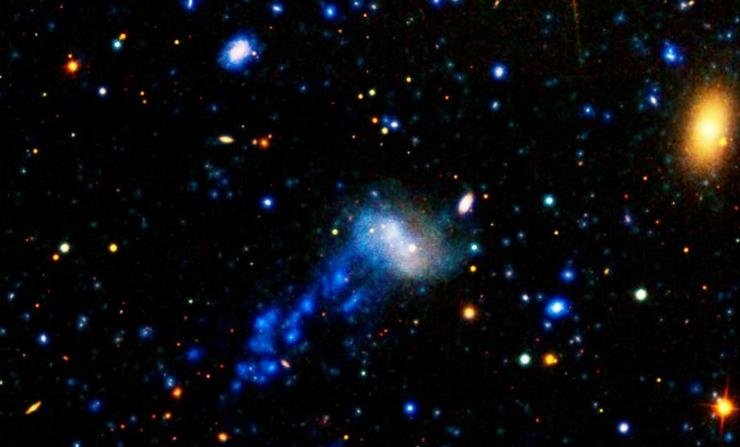Ultraviolet image of dwarf galaxy IC 3418 in the Virgo cluster shows a gas trail streaming behind it, which a new study presents as evidence the galaxy is dying. (NASA/JPL-Caltech)
Astronomers have investigated dwarf galaxy IC 3418 and the trail of fireballs streaming thousands of light years behind, and found evidence of the galaxy's impending death.
“We think we’re witnessing a critical stage in the transformation of a gas-rich dwarf irregular galaxy into a gas-poor dwarf elliptical galaxy -- the depletion of its lifeblood,” lead author Jeffrey Kenney of Yale University said in a release.
Galaxies are star factories, and gas depletion leads to infertility. "Stars, planets, and life can form only if a galaxy has gas to make them," Kenney said. Inside the Virgo Cluster group of galaxies -- the nearest group to the collection that includes our own Milky Way -- galaxy IC 3418 is now nearly out of gas.
The core of IC 3418 stopped making stars between 200 and 300 million years ago, according to researchers. But its fireball tail shows evidence of more recent star formation -- within the last few million years.
Researchers believe the core depletion and the bright gas tail are due to "ram pressure stripping." As gases mix in the space between galaxies, pressure builds, forcing the gases inside a galaxy out in the form of fireballs, leaving denser objects and stars behind.
By way of analogy, Kenney explained, "If you hold popcorn and unpopped kernels of corn in your hand and stick it out the car window ... the air will blow away the popcorn but leave the denser unpopped kernels in your hand."
The researchers used the WIYN 3.5-meter telescope in Arizona and the twin Keck 10-meter telescopes in Hawaii to perform optical imaging and spectroscopy. The team confirmed the ram pressure stripping and presented evidence the galaxy is near death.
"Until now, there has been no clear example of this transformation happening," Kenney said. The study was presented this week at the 222nd meeting of the American Astronomical Society in Indianapolis, and will be submitted to the Astrophysical Journal.















